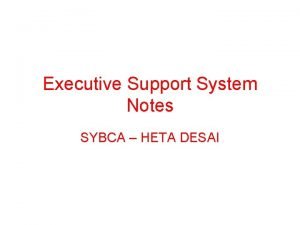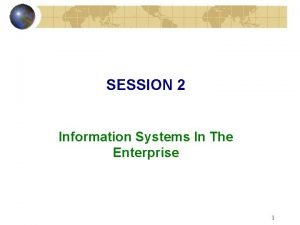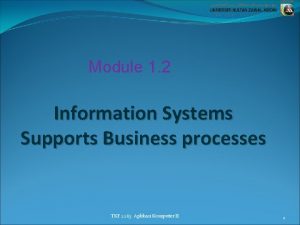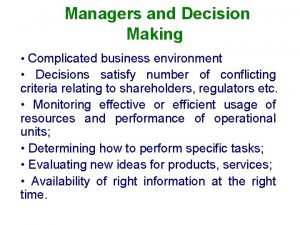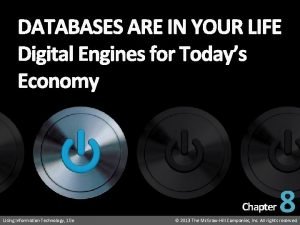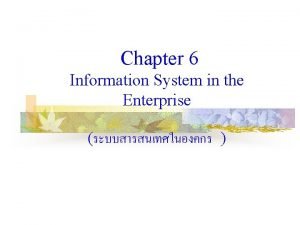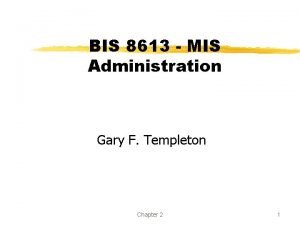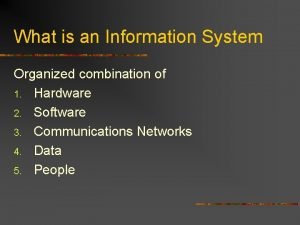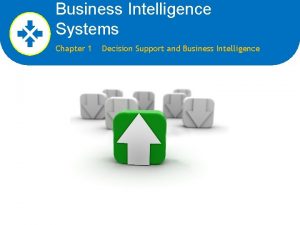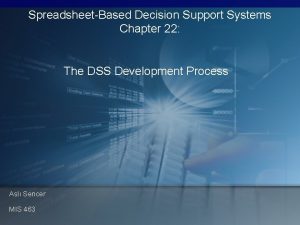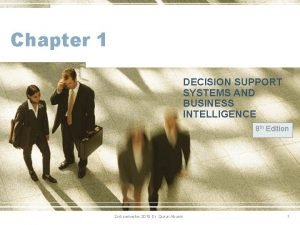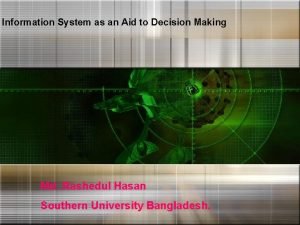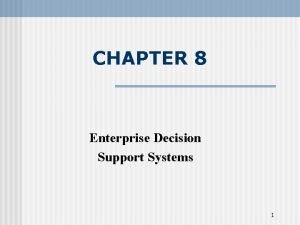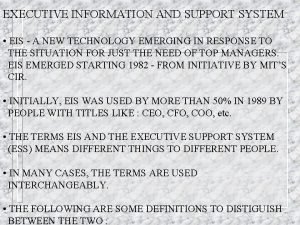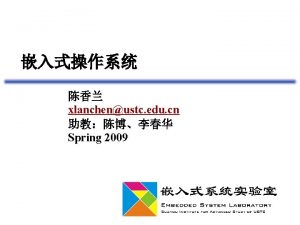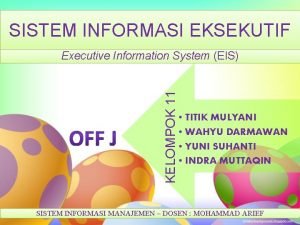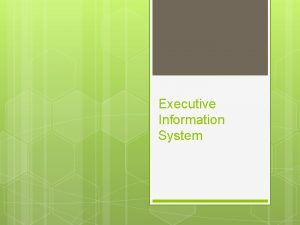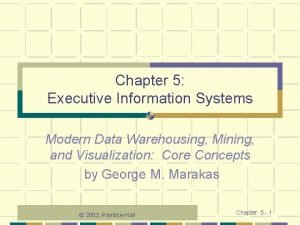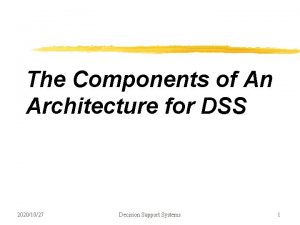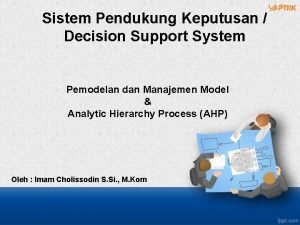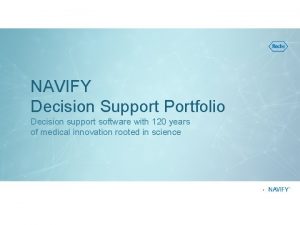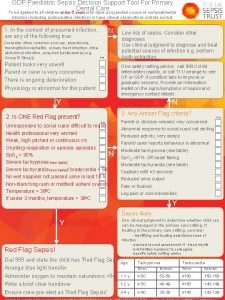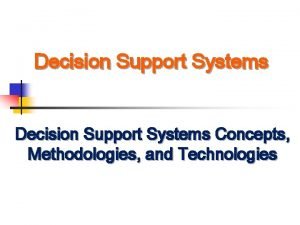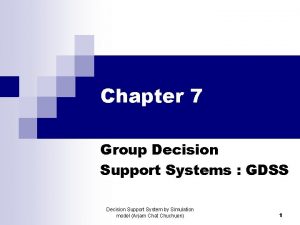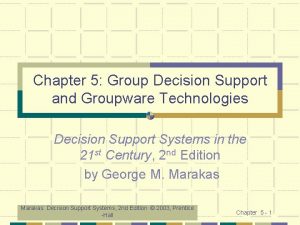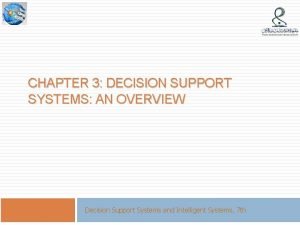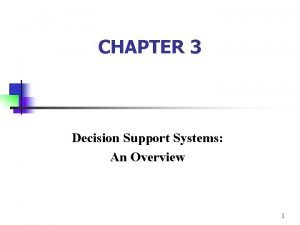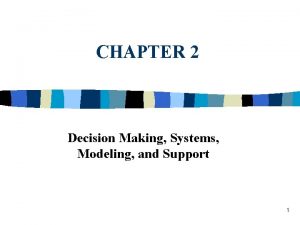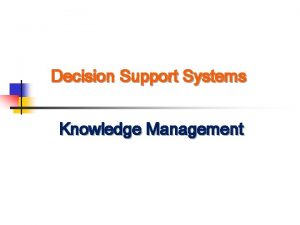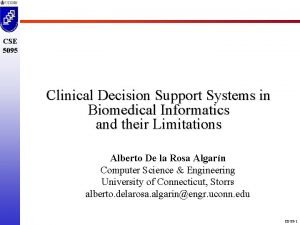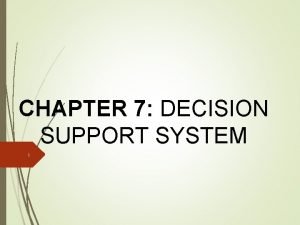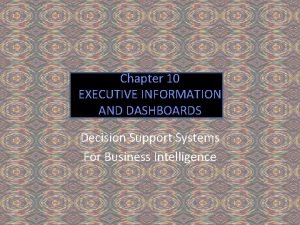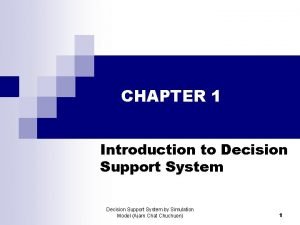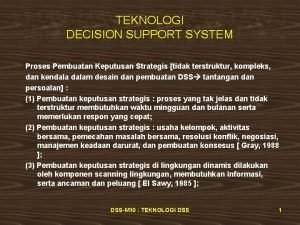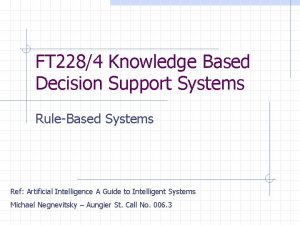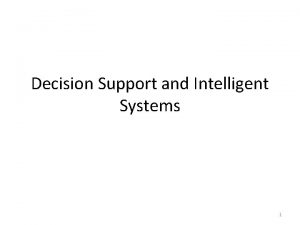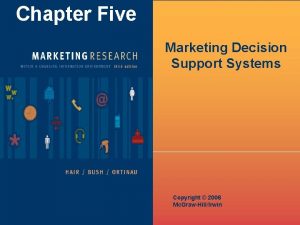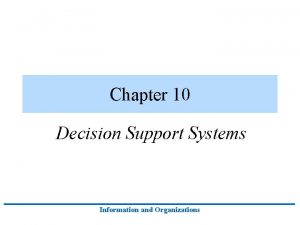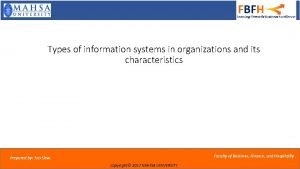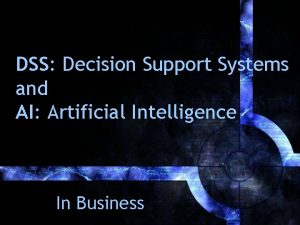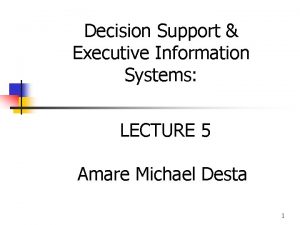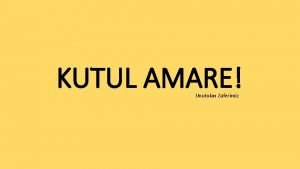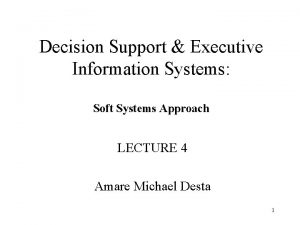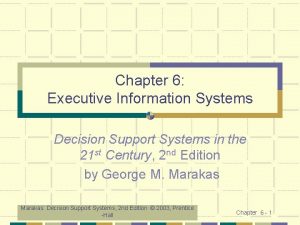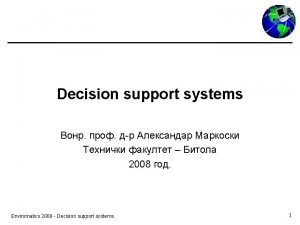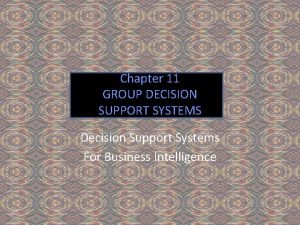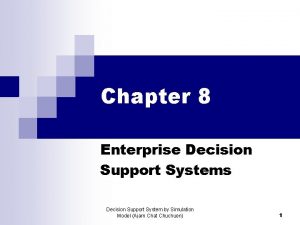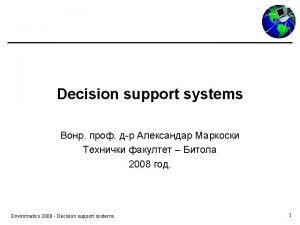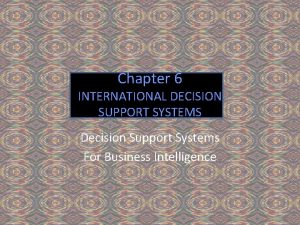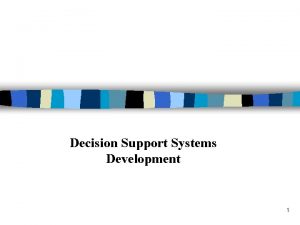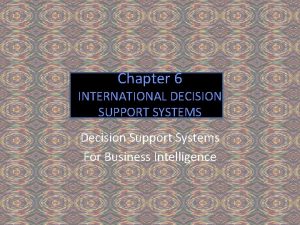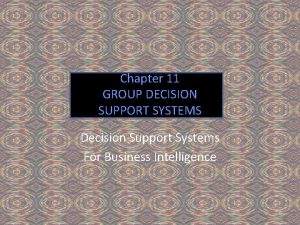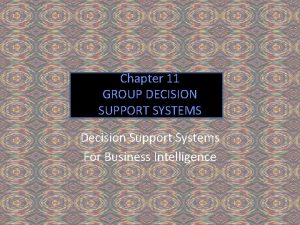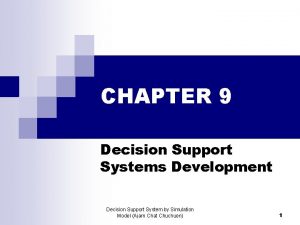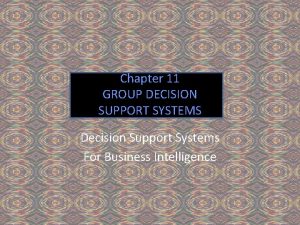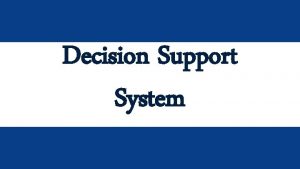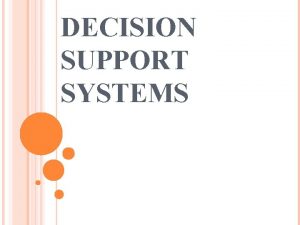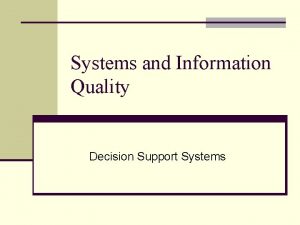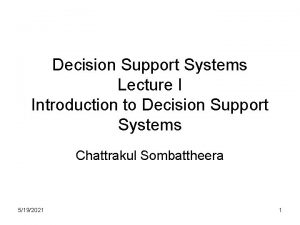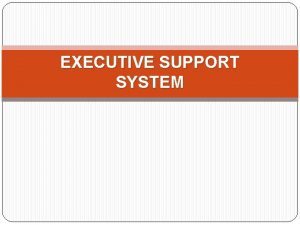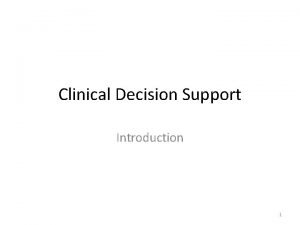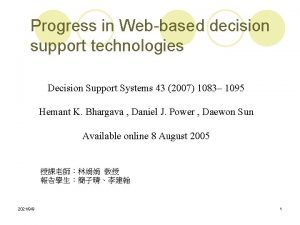Decision Support Executive Information Systems LECTURE 8 Amare





















































- Slides: 53

Decision Support & Executive Information Systems: LECTURE 8 Amare Michael Desta 1

Managing knowledge in knowledge work: How operations are organized in “traditional” work e. g. in manufacturing sector n Different operations follow each others in logical order until the task is completed 2

Managing knowledge in knowledge work - (Contd…. ) Could the same happen in knowledge work or is it “chaotic” or less organized by its nature? n What is the difference between the logistics of n n physical components information / knowledge components? 3

Knowledge flow (logistic) and utilization of knowledge resources Available tacit knowledge resources Unavailable tacit knowledge resources transf dia er me transf er me Knowledge acquisition -defining the requirements -localizing knowledge -accessing knowledge -absorptive capacity dia Knowledge outcomes -embrained knowledge -embodied knowledge -encultured knowledge -embedded knowledge -encoded knowledge Knowledge creation & reuse -skills & competencies -tools & methods tran sfer edia med rm nsfe ia tra Available explicit knowledge resources Unavailable explicit knowledge resources 4

Knowledge Management, (KM) - the need and the reality The move from an industrially-based economy to a knowledge or informationbased one in the 21 st Century demands a top-notch KM System to secure a competitive edge and a capacity for learning. 5

Knowledge Management – the importance n n The new source of wealth is K, and not labor, land, or financial capital. It is the intangible, intellectual assets that must be managed. The key challenge of the Knowledge based economy is to foster innovation 6

The Knowledge Economy For several decades the world's best-known forecasters of societal change have predicted the emergence of a new economy in which brainpower, not machine power, is the critical resource. But the future has already turned into the present, and the era of K has arrived. "The Learning Organization, " Economist Intelligence Unit” But do you all agree? 7

The Knowledge Economy – rest on THREE pillars n n n The role that K plays in transactions: it is what is being bought and sold; both the raw material and the finished goods The concurrent rise in importance of K assets, which transform and add value to knowledge products The emergence of ways to manage these materials and assets, or KM 8

Two Kinds of Knowledge K is intangible, dynamic, & difficult to measure, BUT without it no organization can survive. n Tacit: or unarticulated K is more personal, experiential, context specific, and hard to formalize; is difficult to communicate or share with others; and is generally embedded in the heads of individuals and teams. n Explicit: K can easily be written down and codified. 9

The main issues are – how to n n n Design and install techniques and processes to create, protect, and use known K. Design and create environments and activities to discover and release K that is not known, or tacit K. Articulate the purpose and nature of managing K as a resource & embodying it in other initiatives and programs. 10

Do we really need KM System? n n n Competitive success will be based on how strategically intellectual capital is managed Capturing the knowledge residing in the minds of employees so that it can be easily shared across the enterprise Leveraging organizational knowledge is emerging as the solution to an increasingly fragmented and globally-dispersed workplace 11

Do we really need KM System? (Contd…) n n Instead of constantly reengineering and downsizing: talented people are assets to be developed for a global 21 st Century The reuse of knowledge saves work, reduces communications costs, and allows a company to take on more projects. 12

The Successful Managing of Knowledge Focus on FIVE tasks: 1. Generating knowledge 2. Accessing knowledge 3. Representing and embedding knowledge 4. Facilitating knowledge 5. Transferring knowledge It is a process of instilling the culture and helping the people in it find ways to share and utilize their collective knowledge. 13

KM – the enablers n n n Leadership Knowledge champions, such as CKOs Culture Access Technology Learning Culture 14

More on the importance of Corporate Culture n n Changing the culture is imperative. To create a climate in which employees volunteer their creativity and expertise, managers need to look beyond the traditional tools at their disposal: finding ways to build trust and develop fair process. That means getting the gatekeepers to facilitate the flow of information rather than hoard it. And offering rewards and incentives 15

The technological divide n Generating organizational K invariably means converting the tacit K of the individual into explicit K accessible by all. IT is most effective when it enables this social process. n Organizations must think through their technological systems. n Technology such as Intranets and advanced collaborative software have made KM possible. 16

Organizational Changes n n Lines between departments and operating divisions blur KM even completely collapses boundaries A KM system cannot work through hierarchies Individual and team learning process must become the true driver of organizational learning 17

Organizational Knowledge - Why is it Important? n n Knowledge can be embedded in processes, products, systems, and controls Knowledge can be accessed as it is needed from sources inside or outside the firm It is versatile and can be transferred formally, through training, or informally, by way of workplace socialization It is the essence of the competitive edge! 18

Why KM? What’s the big deal? n n n By instituting a learning organization (KMintensive), there is an increase in employee satisfaction due to greater personal development and empowerment. Keep your employees longer and thereby, reduce the loss of intellectual capital from people leaving the company. Save money by not reinventing the wheel for each new project 19

Why KM? What’s the big deal? (Contd…. ) n n n Reduce costs by decreasing and achieving economies of scale in obtaining information from external providers. Increase productivity by making K available more quickly and easily. Provides workers with a more democratic place to work by allowing everyone access to K 20

Why KM? What’s the big deal? (Contd…. ) n n n Learning Faster With KM Learning fast to stay competitive KM software and technological infrastructures allow for global access to an organization’s K, at a keystroke 21

Successful KM programs – the indications n n n Information is widely disseminated throughout the organization Accessible at a fast rate of speed. Virtual communities of practice share what is known in a global fashion, independent of time zones and other geographic limitations. Business without boundaries broad, often virtual in nature. Collaboration to support continuous innovation 22 and new K creation.

KM and future scenarios n n Where are we going? What are we here for? People need awareness of the whole: in what direction is the organization going? To have a goal to reach in the future can provide great incentive for a KM initiative. Effective leveraging lies within an organization’s capacity for rethinking and recreating. Scenario thinking can help us see the blind spots, and help us create the future 23

Sustainability of a KM endeavor There are three fundamental processes that sustain profound changes such as the introduction of a KM system: - developing networks of committed people - improving business results - enhancing personal results To achieve sustainability, there must be a focus on learning and learning how to harness the learning capabilities that lead to innovation. 24

Sustainability of a KM Endeavor (Contd…. ) n n For significant change to lead to sustainability, hierarchical control must be put aside. The emergence and development of informal networks must be supported so that people can share their tacit knowledge and help one another. Managers need to surrender control. And mental models need to be examined. 25

KM Software Tools n n n n Globalserve Knowcorp Hyperknowledge Micro. Strategy The Molloy Group Knowledge. X Inc. Web. Farming. com Softlab Enabling Tools n n n Imagination Excalibur Technologies Imaging Solutions Grapevine Technologies Intraspect Software Milagro: The Power of Imagination 26

Knowledge Management - the essence n n Is understanding and valuing intangible assets over tangible. Understanding that human and intellectual capital are the greatest resources Managing the skills and competencies that lie within an organization, and allowing them to blossom Allowing people to be the best that they can be; optimizing performance. 27

KM & Systems – the main focus Key questions I’d like to raise: n What is the relationship between KM & systems? n Can “knowledge” serve as a unifying concept for understanding organizations and systems? n Can there be design principles and techniques based on KM concepts, for designing organizations and their systems? 28

KM as a management concept / approach n A parade of management ideas n n n n n Classical administrative theories 1940’s Scientific management (e. g. Taylor) 1950’s Human relations approach … TQM 1980’s BPR 1990’s KM !! 2000~ … ? ? Is KM one among many approaches? n Shouldn’t knowledge be a fundamental concept for understanding and managing organizations? 29

Knowledge in Computing & IS The trend is toward (increasingly explicit) “knowledge representation” in systems Programs 1960’s. Database schemas (data independence from programs)1970’s. Conceptual data modeling (domains, enterprises) 1980’s. Knowledge-based systems (knowledge about world separate from inference engine) 1980’s. Knowledge sharing among systems (“ontologies”) 1990’s. Software agents 1990’s. Semantic web 2000’s. The Question is: What is the role of knowledge in IS? Shouldn’t knowledge be a fundamental concept in IS? - 30

What is the role of knowledge in IS, and IS development? n n n There is knowledge in: Where is the knowledge? What kinds of knowledge? n User organization Whose knowledge? n Developer organization How does knowledge get “into” the systems? n Various artifacts What is change effected? Requirements Analysis Systems Design Software Implementation ERD Forms Spec Architecture Update Marketing Authorize Credit Tables Order Entry Bill Customer VB Code VC++ Code Schedule Delivery Inventory Knowledge about world Abstractions about system Operations on system 31

Knowledge in organizations and systems -Management is about achieving effectiveness through K and action - Info systems (development) is about converting (organizational) K into (automated) action. Can there be a theory of K and action to help understand, analyze, and design organizations and their systems? n Limited KM perspective: n How to manage the knowledge in organizations and systems n Broader perspective – K as unifying concept: n How to design effective organizations and systems? 32

KM systems as specialized classes of systems or “applications” e. g. , [Alavi Leidner 01] [Marwick 01] [Smith Farquhar 00] n n n n n Groupware n Taxonomies Data mining n Document classification Learning tools n Portals & metadata E-bulletin boards n Text search Knowledge repositories n Summarization and databases, FAQs n Relationships discovery Discussion forums n Visualization Knowledge directories n … Expert systems Workflow systems Contrasted with more conventional information systems 33

Five Paradigms of IT Support - a rough typology 34

1. the “processing” paradigm Here, the focus is on the processing (usually fixed a priori) E. g. sales orders processing, bank account statements, teller machine processing. . . Info. operations: n calculate n transform n. . . Info. structures: data items lists arrays trees. . . Qualities emphasized: n speed n accuracy n correctness n. . . 35

2. the “repository” paradigm Here, the focus is on the storage and retrieval E. g. document management systems, online catalogues, databases. . . Info. structures: Info. operations: records links/ n create/read/ update/delete relationships indexes n lookup catalogues n navigate. . . n integrate n. . . Qualities emphasized: n persistence n accessibility n integrity n security n. . . 36

3. the “tool” paradigm The focus is on enabling the user E. g. spreadsheet, word processing. . . Info. operations: n manipulation of user’s information representations n. . . Info. structures: conceptual information structures e. g. , cells in spreadsheets. . . Qualities emphasized: n usability n flexibility n extensibility n. . . 37

4. the “medium” paradigm Here the focus is on communication E. g. email, teleconferencing, groupware Info. operations: n send/receive n share n. . . Info. structures: message conversation conference. . . Qualities emphasized: n presence n fidelity n authenticity n privacy n. . . 38

5. the “agent” paradigm Here the focus is on assisting the user Qualities emphasized: n ability n intelligence n trustworthine ss n. . . E. g. mail filters, web crawlers, knowledge discovery. . . Info. operations: n planning & goal achievement n “understanding” n delegation n. . . Info. structures: Goals tasks/plans conceptual structures interdependencies among agents. . . 39

How much domain knowledge is embedded in the system? Least Embedded knowledge Most Embedded knowledge n Knowledge Media? A provocative concept Suggests that we need to span the full range 40

Major design questions for organizational information systems The term “K Media” suggests that an organization’s IS would be a mix of systems with more/less embedded K Major design questions - Who needs what K to achieve what objectives / responsibilities? - How much to embed in machines? - Where in the organization? - How to make tradeoffs – benefits vs. risks vulnerabilities? E. g. speed, accuracy, economy vs. inflexibility, privacy risks, loss of control, … 41

What design methods and techniques are available? n n Most conventional IS analysis and design techniques are focused on “data” & “processing” HCI research has strengthened design methods especially for “media” and “tool” The Key Question is: n How to bring in knowledge concepts for designing organizations and systems? 42

Modelling Strategic Actor Relationships and Rationales - modeling framework n have goals, beliefs, abilities, commitments are semi-autonomous n n freedom of action, constrained by relationships with others not fully knowable or controllable has knowledge to guide action, but only partially explicit depend on each other n for goals to be achieved, tasks to be performed, resources to be furnished 43

Modelling systems & organizations in terms of Strategic Dependencies among actors (Patient & Health Service provider) 44

Strategic Dependency Relationship I want … Actor A D I can … Car Be Repaired D Actor B 45

46

Strategic Rationales about alternative configurations of relationships with other actors – Why? How else? [Yu AOSE 01] 47

Analysis and Design Support n opportunities and vulnerabilities n n ability, workability, viability, believability insurance, assurance, enforceability node and loop analysis design support n n n raising issues exploring alternatives evaluating, making tradeoffs justifying, settling based on qualitative reasoning 48

Compare: conventional systems modeling agents – implicit knowledge D inputs outputs D wants and abilities 2. goals & (limited) explicit knowledge functional decomposition means-ends alternatives 49

Premises, key concepts D n n n Actors are semi-autonomous, partially knowable Strategic actors, intentional dependencies have choice, reasons about alternate means to ends Intentionality Autonomy Sociality Identity & Boundaries Strategic Reflectivity Rational Self-Interest D wants and abilities means-ends alternatives 50

In conclusion: Question for you In the context of KM and systems - What is organizational knowledge? n Org. knowledge is in people and machines - How is it collected, structured, and managed? n Includes human & automated processes - How does this impact an organization? n Systems need to be designed in organizational context, with attention to K & action of strategic actors 51

In conclusion: Contd…. In the context of KM and systems - What tools do AI & KM provide to do the above? n n Various technologies offer different capabilities with limitations & risks; need analysis & design tradeoffs Conventional systems analysis and design techniques are ill-equipped for analyzing knowledge & action of strategic actors AI and KM offer ideas for new frameworks How are the issues of KM related to DSS? 52

References n n n R. Smith & A. Farquhar. The Road Ahead for Knowledge management – An AI perspective. AI Magazine. Winter 2000. A. D. Marwick. Knowledge Management Technology. IBM Systems Journal. 40(4): 814 -830. 2001. M. Alavi & D. E. Leidner. Knowledge Management & Knowledge Management Systems: Conceptual Foundations and Research Issues. MIS Quarterly. 25(1): 107 -136. 2001. 53
 Decision support systems and intelligent systems
Decision support systems and intelligent systems Sybca
Sybca Executive support systems
Executive support systems An example of a cross-functional business process is
An example of a cross-functional business process is What is mis in computer
What is mis in computer Executive support systems
Executive support systems Executive support systems
Executive support systems Bis mis
Bis mis No decision snap decision responsible decision
No decision snap decision responsible decision Financial management process
Financial management process System is a combination of
System is a combination of Decision support and business intelligence systems
Decision support and business intelligence systems Developing spreadsheet-based decision support systems
Developing spreadsheet-based decision support systems Decision support and business intelligence systems
Decision support and business intelligence systems Decision support system vs expert system
Decision support system vs expert system How do information systems aid in decision making
How do information systems aid in decision making 01:640:244 lecture notes - lecture 15: plat, idah, farad
01:640:244 lecture notes - lecture 15: plat, idah, farad Executive decision meaning
Executive decision meaning Purpose of enterprise decision support system
Purpose of enterprise decision support system Executive information system (eis)
Executive information system (eis) Decision theory lecture notes
Decision theory lecture notes Sargur srihari
Sargur srihari Real-time executive for multiprocessor systems
Real-time executive for multiprocessor systems Kelebihan dan kekurangan eis
Kelebihan dan kekurangan eis Pengertian executive information system
Pengertian executive information system Components of executive information system
Components of executive information system Decision tree and decision table examples
Decision tree and decision table examples Advanced operating system notes
Advanced operating system notes Articulators
Articulators Lecture sound systems
Lecture sound systems Types of information systems
Types of information systems Components of decision support system
Components of decision support system Contoh decision support system
Contoh decision support system Navify decision support
Navify decision support Gdp sepsis decision support tool
Gdp sepsis decision support tool Components of decision support system
Components of decision support system Gdss
Gdss Mdm support technologies in dss
Mdm support technologies in dss Characteristics of a decision support system
Characteristics of a decision support system Components of decision support system
Components of decision support system Systematic decision making process
Systematic decision making process Model driven decision support system
Model driven decision support system Decision support system in knowledge management
Decision support system in knowledge management Iliad clinical decision support system
Iliad clinical decision support system Decision support system objectives
Decision support system objectives Decision support system dashboards
Decision support system dashboards Introduction to decision support system
Introduction to decision support system Proses decision support system
Proses decision support system Knowledge based decision support system
Knowledge based decision support system Benefits of decision support system
Benefits of decision support system Marketing decision support system
Marketing decision support system Disadvantages of decision support system
Disadvantages of decision support system Voyage estimating decision support system
Voyage estimating decision support system Dss ai
Dss ai

